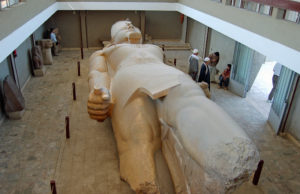
Colossus of Ramses II near Saqqara, Egypt (Photo by Don Knebel)
Memphis, situated on the west bank of the Nile River, became the first capital of a united Egypt in about 3000 B.C. and developed into a major port city. Ptah, the god of creation, protected the city from his temple in the center. The name of Ptah’s magnificent temple, rendered in Greek, provided the name “Egypt” for the entire country. After the Greek pharaohs established Alexandria in the fourth century A.D., Memphis began a slow decline and eventually fell into ruins. Ninth century Egyptian rulers used some of the rubble in constructing Cairo, about 12 miles to the north. Much of what remained found its way to museums around the world.
Some items surviving from the glory days of Memphis and its temple of Ptah have been collected in an open-air museum in the village of Mit Rahina, near Saqqara. A 90-ton carved sphinx, probably honoring Hatshepsut, Egypt’s first female pharaoh, is the largest alabaster sculpture ever found. The most popular item is an enormous statue of Ramses II, who ruled Egypt from 1279–1213 B.C. and is often considered the pharaoh of the Biblical Exodus. The intricately carved statue is almost 34 feet tall, without its missing lower legs and feet. Upon its discovery in 1820, the colossus was offered to the British Museum, which rejected it because of the huge costs of transporting it to London. Today, the statue lies on its back in an enclosure designed especially for it. Another large statue of Ramses II, once outside the temple of Ptah, stands erect nearby.
If you get to Saqqara, don’t overlook the open air museum of Memphis.
Comments are closed.